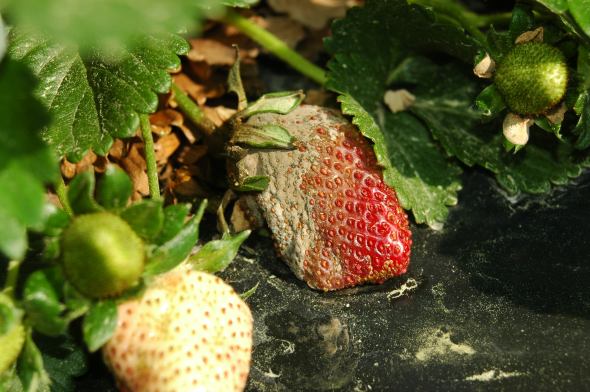How To Prepare For Strawberry Pathogens

During the last few years, Botrytis populations have become resistant to fungicides that resulted in growers losing management options.
Photo credit: Frank Louws
No matter where in the U.S. strawberries are produced, disease problems seem to follow. From Botrytis in the Southeast to Fusarium wilt in the West, you need to be wary of what is lurking in your fields.
In the Southeast, Botrytis, also known as gray mold, can be a problem during cool and wet conditions, says Frank Louws, director National Science Foundation-Center for Integrated Pest Management and a professor of plant pathology at North Carolina State University.
Arguably the most important disease of strawberry, Botrytis can be an issue every year. During the last few years, Botrytis populations that have become resistant to available fungicides have resulted in growers losing options for management, he says.
To avoid resistance, Louws suggests growers refer to the “2015 Southeast Regional Strawberry Integrated Pest Management Guide.” (http://bit.ly/1wwvgEu.)
According to the guide, you should practice the following steps:
Limit the number of times disease control products in the same class of chemistry are applied in one year.
Tank-mix a broad spectrum fungicide such as Captan (Loveland Products, Drexel Chemical Co., Arysta LifeScience, ADAMA) or Thiram (Chemtura Corp.) with Topsin M (United Phosphorus Inc.). Topsin M does not have Botrytis activity due to resistance, but is helpful to control several early season foliar diseases, if they are present.
For cases when there is no risk of Anthracnose and growers need to focus on gray mold control (most fields): rotate two or more of the following: Captan, CaptEvate (Arysta LifeScience), Switch (Syngenta), and Captan plus Fontelis (DuPont).
Understand that resistance can vary from farm to farm. To sample gray mold populations for their resistance profile, contact Clemson University. (For instructions to submit your sample to Clemson, go to http://bit.ly/1AKrXPn.)
A New App Provides Disease Info
You also will soon have an app that will offer advice on disease control. A fruit specialist from Clemson and a computer software designer developed a smartphone tool called MyIPM, which is said to be the first smartphone app to provide strawberry growers with disease information. The app was unveiled at the Southeast Regional Fruit and Vegetable Conference in Savannah, GA, last month.
“Growers will be able to pick effective and safe fungicides for conventional and organic production of strawberry,” according to Guido Schnabel, the Clemson University fruit specialist who worked with software designer Roy Pargas.
“The app will, in a nutshell, tell you with audio, pictures, and text what you need to know about a particular disease and its management,” Schnabel says.(Read more about the app at http://is.gd/StrawberrySmartphoneApp.)
Charcoal Rot And Fusarium Wilt
On the other side of the country, Steve Koike, a University of California Cooperative Extension plant pathologist with Monterey County, says strawberry growers in the Golden State continue to encounter problems with charcoal rot and Fusarium wilt, and the situation is getting worse. (Read more at http://is.gd/FumigationChallenges.)
The diseases were noticed in 2005 not long after some growers began moving away from using methyl bromide, the fumigant being phased out under the Montreal Protocol and the Clean Air Act. As a result, he says growers have limited management practices for these diseases.
Both diseases present similar symptoms: wilted foliage, dead older leaves, and stunted plants. In addition, both are soil borne and can easily move from field to field via contaminated equipment.
Koike advises growers to implement standard IPM practices as they pertain to sanitation that will help to avoid disease spread.
“Power wash equipment and try to reduce the amount of dirt that is moved between fields, or plow and farm in the clean fields first and then move to the infested ones,” he suggests.
Fumigation And Resistant Varieties
In addition to IPM and sanitation, what are your options to control these diseases?
Koike says pre-plant fumigation products are useful, but in the long run we are not seeing the available products clean up the ground the way methyl bromide plus chloropicrin did. Your best bet, he says, is to plant resistant varieties when possible. In fact, research efforts in California are being put into the development of resistant varieties.
To date, several strawberry varieties with Fusarium wilt tolerance are available. For example, Koike says cultivars Portola, San Andreas, and Ventana, from the University of California-Davis, are tolerant to Fusarium.
“So if a grower knows he has Fusarium in his fields, then he could select one of these varieties,” explains Koike. “It is important to understand what ‘tolerant’ means because it shows that the variety isn’t absolutely resistant and could develop disease late in the season.
“A tolerant variety is helpful because the grower can get additional months of harvestable fruit off the plant before it declines as compared to really susceptible plants that simply melt and collapse very early after infection,” he adds. “Unfortunately, I don’t think we have any commercially available varieties that are completely resistant to either one of the pathogens.”
3 Tips To Protect Strawberries From Disease
Frank Louws from North Carolina State University offers a few pointers on how to protect your strawberry plants from pathogens.
1. Use certified plants or plants produced in a similarly stringent program to prevent several major diseases, such as Anthracnose, angular leaf spot, and in many cases Phytophthora crown rot.
2. Invest proper time and resources in land preparation. For example, use fumigation or a holistic land and soil management system such as crop rotation combined with cover crops and compost.
3. Know your enemy. Get a positive diagnosis if there is a problem and follow the 2015 Southeast Regional Strawberry Integrated Pest Management Guide. (Go to http://bit.ly/1wwvgEu.)










